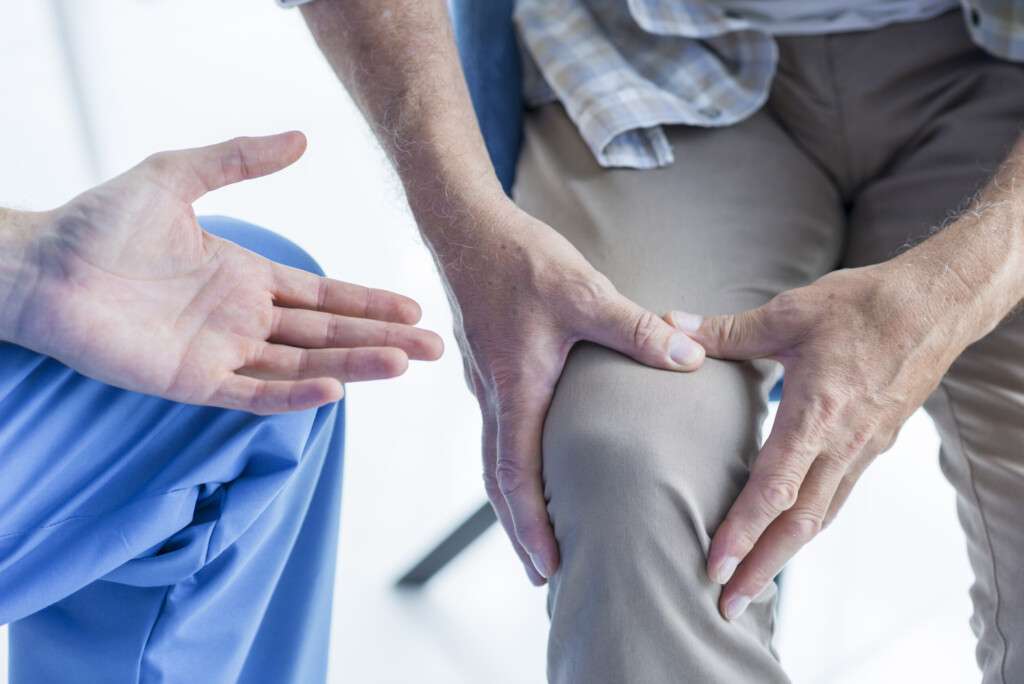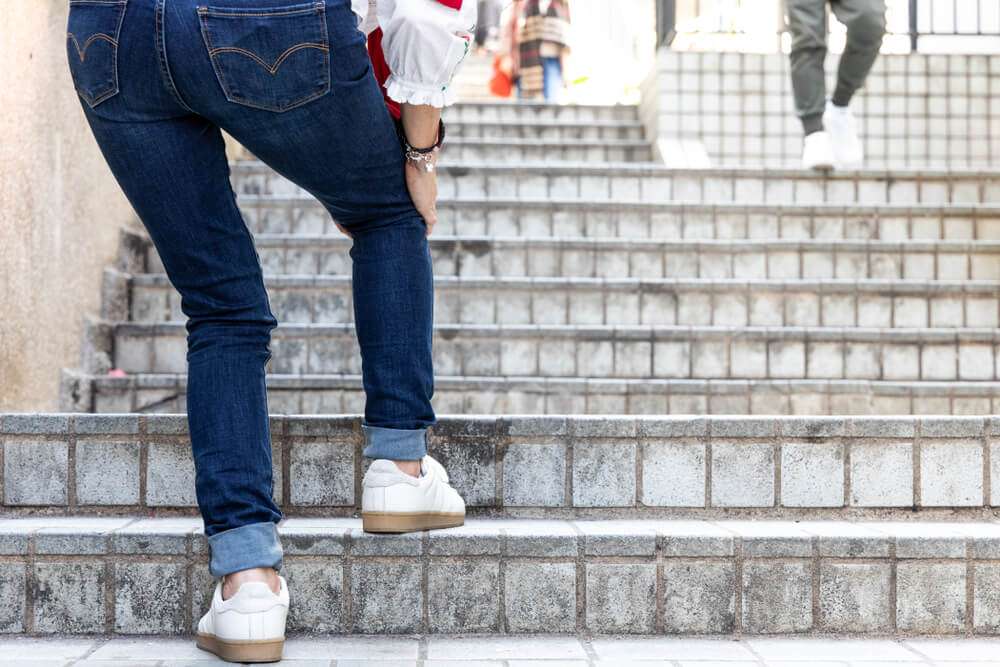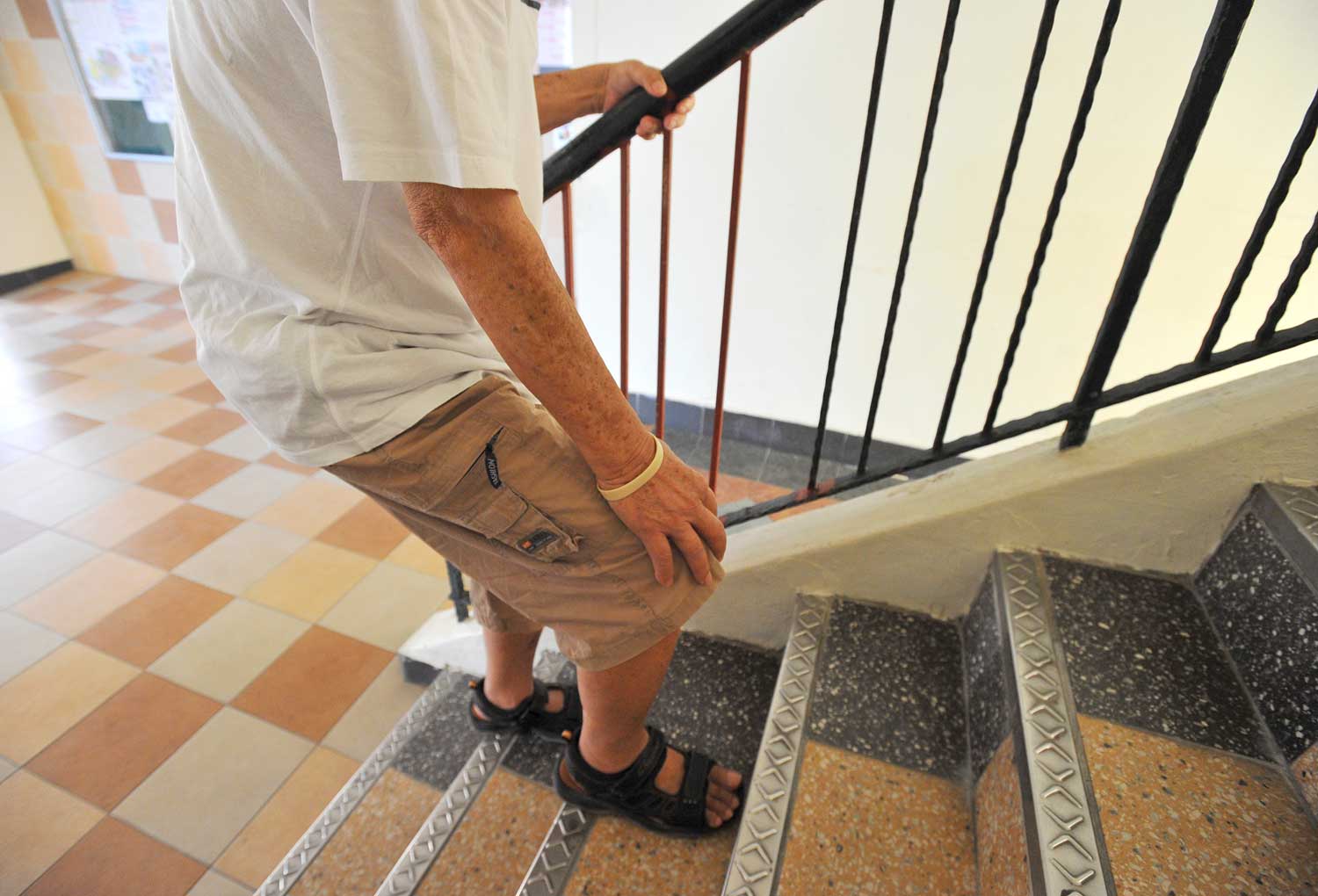Essential Knee Exercises To Make Climbing Stairs Easier & Pain
You are standing at the bottom of that dreaded staircase once again. All you want is that maroon blouse from the armoire in the attic. Why would climbing 13 six-inch elevations feel like surmounting Mount Everest and cause your knees so much agony? Keep reading if you have knee pain with stairs.
Written By: Coach Todd and originally posted on sixtyandme.com
You ponder your options
Ok, maybe I should go at a slight angle this time.
Or maybe if I put more weight on the railings.
Nope. I got it. Ill sing the Hokie pokie and change the key on each step. Yep, that should do it.
Battles with staircases rage on across households every single day. And the variations on how to get up and down those steps would make a Texas Hold em card counter spinning in circles.
Thankfully, strengthening your knee using a few key exercises can make climbing up or downstairs easier and pain-free.
Tips To Go Up And Down Stairs With Less Pain
How To Walk Up And Down Stairs Without Knee Pain
If you’re suffering from knee pain when going up and down stairs, it’s important to diagnose and treat the underlying condition.
At the same time, simply changing the way you walk up and down stairs can bring some relief. These changes can also help you prevent future overuse injuries.
The following guidelines can help you climb and descend steps without pain.
First, be sure to engage your whole foot with each step. Avoid stepping with just your toes when climbing or descending stairs.
Focusing your weight on your toes activates your thigh muscles. These muscles, in turn, increase pressure on the kneecap and push it into the thigh bone. We’ve seen, of course, that it is precisely this contact and pressure that causes knee pain when going up and down stairs.
Engaging your whole foot means planting its entire surface on the step before reaching for the next one. It also means shifting your weight to your outer heel to activate your glutes.
Second, keep your feet and knees aligned. When you step, your knee should be directly above your foot. If it angles in, this could indicate a muscle imbalance. These imbalances and misalignments can also cause or worsen pain and inflammation.
Third, pay attention to your posture. When climbing stairs, lean slightly forward. By leading with your body, you further reduce the pressure on your knees.
You May Like: What Are The Different Types Of Knee Injuries
The Mini Side Stair Exercise
Whoever said, If you dont use it, you lose it was a wise person. I think it might have started with my great uncle Al but I cant be sure about that.
The same thing is true for stairs. Mini dosages of stairs can help you prepare for the real thing.
Use a phone book or a 3-4 inch step. Position yourself parallel to the step because youll be going up sideways.
Why? When you practice going up the step sideways, you naturally engage your glute muscle which is a key muscle used in stair climbing.
So you are training your body to fire up the right muscles when you practice sideways.
Make sure you have a chair on the other side for balance. Start with the leg that often gives you trouble. Lift your foot up and place it on the step. Now that your foot is on the step or phone book, lift your body up.
3 Important things to think about:
Stand up fully. When you are ready to step down. Follow the same steps as above. Ie Put pressure on your outer portion of the heel and keep the knee over the second toe.
How To Address A Hip Labral Tear

The first thing you need to do is modify or pause the activities that aggravate your hip. This will help reduce the swelling and inflammation within the joint and decrease muscle spasms.
Once the pain has started to subside, you can start walking, swimming, or even try an elliptical program as long as it is pain-free.
A hip strengthening program is essential to ensure that the joint is stable for long-term success. The stronger the muscles around the hip are, the less catching and grabbing inside the joint.
We recommend working the hip abductors, strengthening the glutes, and progressing to more functional exercises like squats and lunges.
One of our favorite exercises is the Bulgarian split squat. This works on many muscles around the hip and builds strength quickly.
Don’t Miss: How Long Is Hospital Stay After Knee Replacement
Who Is At Risk For Chondromalacia Patella
Many people are surprised to find their cartilage is damaged because theyve never hurt their knees in the past. Unfortunately, chondromalacia can be brought on by more than an accident or injury.
People who are at risk for developing chondromalacia patella include:
- Those who are overweight
- People who have had an injury, fracture, or dislocation related to the kneecap
- Runners, soccer, basketball, tennis players, weightlifters and exercise enthusiasts, cyclists, and other people who exercise often
- Teenagers and healthy young adults, more often females
How To Perform A Mini Side Stair
Use a phone book or a 3- to 4-inch step. Position yourself parallel to the step because youll be going up sideways. Why? When you practice going up the step sideways, you naturally engage your glute muscle which is a key muscle used in stair climbing. So, you are training your body to fire up the right muscles when you practice sideways.
Make sure you have a chair on the other side for balance. Start with the leg that often gives you trouble. Lift your foot up and place it on the step, then lift your body up.
Steppers are a safe item for this type of exercise. They typically are made with non-slip surfaces and are adjustable.
Recommended Reading: How To Stop Knee Pain When Squatting
Home Remedies To Relieve Knee Pain While Climbing
Treatment of pain in knees while climbing depends mainly on treating the specific underlying cause. Below are given few important tips to alleviate the pain and improve movement.
- Rest to the knee joint from rigorous activities will aid in healing the damaged cartilage and other tissues. Avoid running, walking fast for long period of time or avoid any other athletic activity, however normal walking to perform regular chores should be continued on flat surface.
- Ice fomentation is beneficial in reducing inflammation to the tendons and muscles involved in causing pain while climbing upstairs. Apply ice bag around the knee or put few cubes of ice in a towel and apply it over the knee for 10 minutes 2 to 3 times in a day.
- Keep your legs elevated while resting. It increases blood circulation to the knee area. It also nourishes the damaged tendons and muscles and enhances healing process.
- A gentle massage with coconut oil or olive oil is beneficial in relieving pain and reducing inflammation in the knee.
- Over the counter pain killers and anti inflammatory medicines are beneficial. Take these medicines only after consulting your doctor.
Improve Movements To Eliminate Knee Pain
The lower extremity works as a comprehensive unit performing many of the repetitive tasks at home, work, and during recreational sports. Injuries to one area of the musculature often indicate that additional damage has been incurred by other muscles.
Many therapeutic exercises can help restore proper strength and endurance to the leg muscles. Isometric exercises are often the initial treatment exercises, followed by single plane rubber band exercises for the hip, knee, and ankle: flexion, extension, adduction, abduction, circumduction, inversion, and eversion. Dynamic exercises involving stability foam, rubber discs, exercise ball, and BOSU balls can be performed on the floor. The more unstable of the surface, the more effort and stabilization is required of all the lower extremity muscles.
Vibration plates enhance neuromuscular learning throughout the ankle, knee, foot, hip, and back muscles. Additional strength exercises can be found on the hip, knee, and foot strengthening pages. More information for injuries and treatments for knee pain and foot pain.
Recommended Reading: What Doctor Treats Knee Problems
Causes And Risk Factors
Several different risk factors can make you more likely to develop chondromalacia patella. These include:
- Having excess weight
- People with less muscle mass
- Those with a previous knee injury
Chondromalacia patella is also more frequently seen in individuals who participate in endurance sports like running or biking. In this situation, muscular imbalances cause the kneecap to track improperly in the femoral groove, leading to repetitive rubbing and irritation.
Check Out Our Latest Book
“Beat Knee Pain: Take Back Control” tells you everything you need to know to help you work out what is wrong with your knee and gives you loads of great advice on how to get back to doing what you love. It has an average rating of 4.8/5 and is ranked the #2 Best Seller in Orthopedics on *.
*Ranked #2 Best Seller in Orthopedics on Amazon.com in October 2021
Page Last Updated: 11/24/21
Also Check: What Does Arthritis In The Knee Feel Like
What Are Some Potential Causes Of Knee Pain That Occurs When Climbing Down Stairs
While you should never self-diagnose and treat an injury, learning about potential causes can help you take a more active role in your treatment while helping you to be more engaged with your care provider.
Here are four potential causes of knee pain that can cause pain when climbing or descending stairs:
For these and other causes of knee pain, one method of treatment that can be particularly effective is physical therapy.
Knee Pain When Climbing Stairs Causes: Home Remedies To Relieve It

Pain in knee is a debilitating condition which can affect a persons daily movement. Many people may be able to walk on flat surface without any knee pain, but no sooner they try to climb the stairs, they experience pain in their knee. It is quiet frustrating, especially for people who have to climb staircase in their house.
Usually it is the front of knee, the patellofemoral joint which is affected while climbing. It is a joint where the knee cap lies in front of the groove of lower end of thigh bone.
You May Like: What Is The Best Tens Unit For Knee Pain
Climbing Stairs & Knee Pains: Is There A Way To Do It Correctly
Are you suffering from knee pain when you walk up or down the stairs? If yes, you might be looking for the reasons behind the knee pain and how you can prevent knee pain while climbing the stairs. If this is the case with you, then you are landed on the right page ! In this article, we will discuss the reasons behind knee pain when climbing stairs and the correct way to climb stairs if you are indeed having knee pain.
When you walk up or downstairs, your knee moves repeatedly. These repeated movements can lead to knee problems over time. In some cases, people may start to feel pain in their knees when climbing up the stairs. There could be several reasons behind this pain but two of the most commonest reasons are mentioned below.
Knee Pain While Climbing Stairs May Signal Early Osteoarthritis
If you feel knee pain while going up and down the stairs, you may be experiencing the first symptoms of osteoarthritis.
New research, published in the medical journal Arthritis Care & Research, found that climbing stairs appears to be the first weight-bearing activity that causes osteoarthritis pain. Researches say its important to detect the condition early because it can help increase the likelihood of people finding effective treatment.
At present we have little concept of early osteoarthritis and often only see people when they have significant longstanding pain and loss of function, said Philip Conaghan, professor of musculoskeletal medicine in the University of Leeds School of Medicine. This research is vital to understanding early symptoms of knee osteoarthritis. Knowing this will help us intervene earlier, perhaps leading to more effective ways of treating this very painful condition.
Nearly 27 million Americans age 25 and older are diagnosed with osteoarthritis or, OA, according to published studies. Previous research reports that knee OA is the leading cause of functional limitation among older adults, making walking and climbing stairs difficult. About 80 percent of OA patients have some limitation in movement, with 11 percent of adults with knee OA needing assistance with personal care assistance, according to the National Health and Nutrition Examination Survey.
Don’t Miss: What Makes Your Knee Pop
Why Does My Knee Hurt When I Climb The Stairs
Joe asked himself that question every time he stood at the bottom of the steps and looked up at the landing. The stairs had become a physical endurance test. Each step caused searing pain in his knees no matter how slowly or carefully he climbed. The pain, which started in his right knee, now affected his left. Most of the time, Joe avoided the stairs by sleeping on the couch in the den and storing his clothes in the desk drawers. But, today he needed his suit from the bedroom closet.
Has knee pain ever caused you or a loved one to avoid activities?It may be due to damaged cartilage in your knee. The clinical name for the condition is chondromalacia patellae, also known as Runners Knee.
Treat Your Knee Pain With Motion Orthopaedics
If you are experiencing knee pain that is preventing you from going about your daily activities, the team at Motion Orthopaedics can help. Our comprehensive approach to knee care includes everything from diagnostics and imaging to treatment and rehabilitation.
Motion Orthopaedics is devoted to maximizing our patients quality of life. We achieve this by providing compassionate, individualized care and innovative solutions for our patients. If you are ready to start climbing stairs pain-free, contact us today to schedule an appointment.
Read Also: Where Can I Get My Knee Drained
Preventing Knee Pain When Walking Up The Stairs
If you are frequently experiencing pain in your knee, there are several things you can do to prevent pain when going upstairs. Using proper form is key to preventing further damage to the knee joint. When going upstairs, be sure to:
- Use your whole foot to step on each stair
- Keep your knees aligned with your toes
- Avoid putting all of your weight on one leg
- Push off each step from your heel
Furthermore, using handrails when climbing stairs is always a good idea, as this may help take some pressure off your knees. Finally, be sure to wear supportive shoes with good arch support to help reduce the stress on your knees.
What Are The Causes Of Front Knee Pain When Walking Up Steps
Knee pain can significantly affect your ability to move around, particularly when you need to climb stairs. Pain in the front of your knee is typically related to your patellofemoral joint, where your kneecap sits in front of your thigh bone. Stair climbing increases compression at this joint. “Patellofemoral pain syndrome” is a term used to describe different conditions that commonly cause pain in the front of your knee. See your doctor to accurately diagnose your knee pain.
Video of the Day
Don’t Miss: How To Strengthen Your Knees At Home
Why Is It Important
If you have knee issues, I recommend starting at a 45-degree angle first rather than a 90-degree angle. This will help you build strength around your knee and prepare you for stair climbing.
This exercise is weight-bearing so it helps build bone density and strength. But since its an isometric , it puts less stress on the knee.
How To Address Lumbar Radiculopathy

The most important thing to do with lumbar radiculopathy is to keep moving! If you become sedentary, the muscle and joints in the back will stiffen up and make this much worse.
We highly recommend walking, swimming, and doing some gentle stretching to maintain your range of motion as you are able.
Aerobic activity such as walking or swimming helps increase blood flow to the area, which will help manage swelling and inflammation.
Stretching is essential to maintain the range of motion in the hips, low back, and legs. We recommend starting with a simple hip stretch called the figure 4 stretch.
If sitting for long periods seems to increase your pain, try using a lumbar support pillow when you have to be in these positions.
We also recommend avoiding high-impact activities or any exercises that require heavy lifting or compression through the spine.
Finally, strengthening the core, glutes, and muscles of the low back is crucial to speed up healing and prevent this from coming back again once its all healed.
If this is the cause of your hip pain when you are ascending or descending stairs, there are typically a few modifications that can make a significant difference.
The first is to tighten your abdominal muscles when you are performing stairs. Tighten your stomach by bringing your belly button towards the spine and holding it when you are doing the stairs. This typically does the trick for most people.
Don’t Miss: Why Does My Knee Hurt When I Straighten It